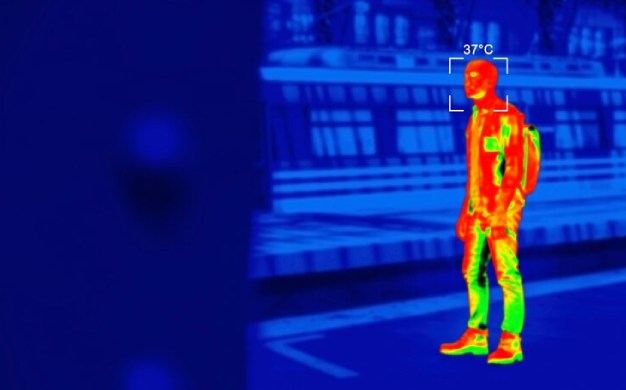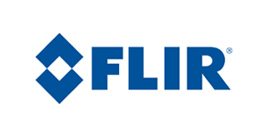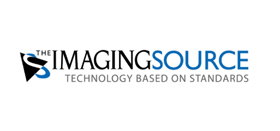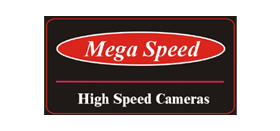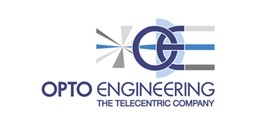Makers of machine vision systems have long relied on visible light cameras when building systems to give their customers the ability to perform quality control in all sorts of production environments. Recently, another type of sensor, the short-wave infrared (SWIR) linescan camera, has improved in resolution and come down in price enough that system integrators have started to develop new inspection systems that take advantage of the unique advantages offered by such cameras.
Looking With New Eyes
The SWIR part of the spectrum, which is generally considered to be wavelengths between 900 and 2500 nm, can pick out features that are not immediately obvious in visible light. For instance, it’s excellent at sorting fruits and vegetables and detecting foreign objects, such as packaging, mixed in with the food.
Say the customer is a produce distributor who needs to inspect frozen peas, to make sure there’s no debris among them. If there’s a small piece of plastic, similar in shape, size, and color to the peas, machine vision using visible light might not notice it. SWIR light, however, is strongly absorbed by water, so frozen peas with their high water content would be very dark in the image. A piece of plastic, which has little or no water content, would instead reflect the light and stand out sharply from the peas, and the sorting machine could use an air jet to blow it out of the pile (see Fig. 1).
In a very different example, the photovoltaic industry can also benefit from the properties of SWIR. Inspecting the silicon wafers that go into solar cell arrays is crucial, as defects within them can severely impair their efficiency at converting sunlight to electricity. Visible light, however, can only look at the surface of the wafers. But at SWIR wavelengths, the wafers are transparent. That makes it possible to find cracks inside them that wouldn’t be apparent in a normal visual inspection.
Hyperspectral Imaging – based on area scan cameras
SWIR cameras can also play a role in hyperspectral imaging, which relies on multiple wavelengths of light in applications ranging from inspecting food to sorting different types of plastic waste to characterizing different materials. Hyperspectral imaging includes both visible and SWIR wavelengths, and sometimes, depending on the application, goes further into the infrared to include midwave and longwave infrared wavelengths as well.
Hyperspectral imaging systems add a dimension to the images they collect. Though they are used in line scan setup, they rely on area (two-dimensional) detectors. That’s because the scans are passed through a prism, diffracting the light, with different wavelengths falling on different parts of the detector to create a layered image. Individual wavelengths supply different information about the objects being imaged.
Often, hyperspectral systems are used in research to develop applications. Then, once the best wavelengths for detecting what’s sought have been determined, they’re replaced with simpler line scan systems that only look at a limited number of wavelengths, for example by using pulsed LEDs.
A Narrower View
The major difference between a line scan camera and an area camera is apparent in the name. A line scan camera consists of a single row of pixels that image a narrow line across the object being scanned, whereas an area camera captures a much larger area in each frame. Each pixel absorbs light from the object and converts it into a charge, and adjacent lines add up to an image of the whole object. In order to do that, either the scanner or the object must move so that different sections are within the sensor’s field of view.
That movement makes a line scan camera well suited to a production environment, where parts being inspected often move along a conveyor belt, or where objects being sorted drop into a bin. Fruits and vegetables, for instance, typically fall past the detector. Because these applications already involve motion, they fit naturally with line scan cameras, while avoiding the risk of blurring the image that the motion might produce in an area camera. A line scan image is also less likely than an area image to contain faulty pixels that can hide the defects being sought, and they provide good resolution at an affordable price.
How To Select An Infrared Line Scan Camera
The Wavelength
In deciding whether to turn to SWIR imaging for your application, it is important to know whether there is some aspect of the objects being viewed that stands out at SWIR wavelengths. In applications such as inspection of markings—labels and bar codes, for instance— there is no reason to use IR light, as visible imaging does a much better job, at a much lower cost.
Knowing the SWIR wavelength you need is often critical to the success of the setup. Which wavelength is best depends on the intended application. For food sorting based on moisture content, the typical wavelength used is 1450 nm, which is very strongly absorbed by water (see Fig. 2). Other food inspection applications might require different wavelengths. SWIR can be used to identify different aspects of food, such as the fat content in meat or a bruise in an apple, that reflect or absorb light differently from the area around them. It can measure how fresh a fish is. Or it can look for impurities.
Melamine, an industrial chemical that has been found to be contaminating powdered milk, stands out in SWIR light, for instance.
Nowadays, the typical SWIR camera uses a detector built from indium-gallium-arsenide, which is sensitive to light from 900 to 1700 nm. Some applications, however, require wavelengths as long as 2000 or 2500 nm, which is sometimes referred to as extended SWIR. The mining industry, for instance, sometimes turns to those wavelengths, which require a different or modified material in the detector.
No one specific wavelength is used for silicon wafer inspection. The silicon is transparent at wavelengths above 1200 nm, so anything beyond that works. Of course, finding small defects requires high resolution and often large magnification, and the shorter the wavelength is, the higher the resolution and the smaller the defect it can detect.
Resolution
If the user wants to build a megapixel image from the camera— that is, an image with a million pixels—he can achieve that by scanning 1,000 lines that each have 1,024 pixels. So, a system that scans at a relatively low line rate of 1 kHz—1,000 lines per second—can capture a megapixel in one second. In order to achieve that without significant overlaps or gaps between the lines, the speed of the conveyor belt has to match with the line rate and the camera’s field of view.
The resolution of the system should also match the application, and system designers can figure that out by considering the field of view of their scanners and the size of the particle or defect they’re trying to find. Generally, people looking for foreign matter in fruits and vegetables are interested in macroscopic objects, so it’s easy to achieve the necessary resolution. Depending on the setup, the field of view may be up to one meter. So, a 512-pixel camera may be sufficient.
For silicon wafer inspection, the defects being sought are smaller, so the resolution needs to be higher (see Fig. 3). Such a system might call for a 2,048-pixel camera. One relatively new technique for finding smaller defects in wafers is an approach called “transflection,” a combination of transmission and reflection. Light that has transmitted for a short distance inside the wafer is then reflected, and any crack in the way will cast a shadow, which tends to be bigger than the crack itself and therefore easier to spot. Transflection systems require careful optimization by the system designer.
Noise
Noise is also important in these systems. The main contributor is the detector’s read noise and it defines the limits of detection. As the line rate increases, the exposure time, and thus the number of photons reaching the detector during the exposure time, decreases. At a rate of 1,000 lines per second, for instance, the exposure time can be a maximum of 1 ms. Increasing the line rate shortens the exposure time even more, so it becomes crucial that the noise doesn’t overwhelm the light signal collected by the detector. Of course, it is possible to increase the light intensity in the system so that more photons per second reach the detector, but that’s not always easy; it drives the cost of the system up and can create problems with heat. For this reason, detectors with low noise levels are desirable.
Beyond Cameras
An inspection system includes several components that work in conjunction with the SWIR line scan camera. One key component is the light source, which can consist of LEDs, lasers, or halogen lamps. Of course, the source has to provide the right wavelength for the application, but there are other considerations as well. For instance, in order to get uniform illumination along the whole line of pixels, it might be best to match the camera with a line of LEDs. And the setup might be arranged in a number of different ways. For food sorting, perhaps the best place to locate the source would be next to the camera, while for semiconductor inspection it might make more sense to put the source on one side of the wafer and the camera on the other. Users might also want to look at a silicon wafer at an angle to see reflected light inside it, the better to notice small defects.
Another consideration is synchronizing the camera with the light source. As the objects move past the camera, the camera snaps individual frames. It’s important that the light be illuminating the objects at the moment the camera fires. The standard method is to send a triggering pulse to the camera and the light source at the same time, using an external trigger connector or something like the CameraLink data and control interface. That functionality is standard on any commercial machine vision camera. In some applications, users might look for different characteristics with two or three wavelengths. Triggering different sources, for example LEDs with different wavelengths, at different times allows the system to sort the wavelengths temporally.
An Evolving Field
While machine vision systems based on visible light have been widely used for years, SWIR line scan imaging is relatively new and not as widespread. In part, that is due to the lower resolution of the IR systems, with maximum pixel counts of 2,048 as compared to 16,000 for visible.
But in recent years, the noise and resolution of SWIR cameras have improved at the same time the cost has come down. That has led to their adoption in high-volume applications such as food sorting and semiconductor inspection. Making higher resolution cameras will require building smaller pixels, and there are technological challenges that must be overcome to achieve that. The main focus of camera manufacturers today is in reducing the noise in the system and increasing the scanning speed.
The Right Answer
System integrators who build machine vision setups for their customers can benefit by using SWIR line scan cameras in their systems. For the right application, IR light provides the ability to see things that visible light does not. It can peer beneath the surface of a silicon wafer to look for cracks, for instance, or make inedible material stand out sharply from food items that in visible light may look very similar.
Machine vision integrators have several factors to consider when incorporating a SWIR line scan camera into their systems. Which wavelength is right for the application? Which light source works best? What level of resolution is necessary? Does the scanning speed match the speed at which the inspected objects are moving? Is the noise low enough to get a readable signal with that light source and scanning speed?
If these questions have the right answers, system integrators may find that SWIR line scan cameras provide the capabilities to give their customers the machine vision that they’re looking for.
Also Read: How will the Latest Image Sensors Impact the Future of Machine Vision?
Back to All Robotics and Autonomous Systems Articles, Resources and News
Share This:
To Know More About Line Scan Cameras in Singapore Contact MVAsia Infomatrix Pte Ltd at +65 6329-6431 or Email us at info@mvasiaonline.com
Source - xenics.com


